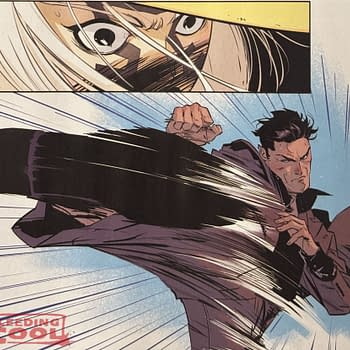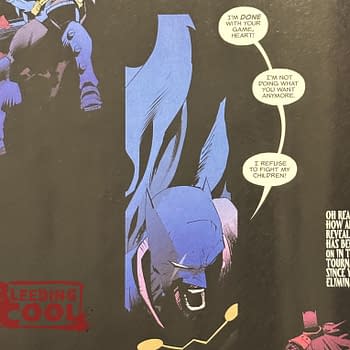Posted in: Comics | Tagged: Comics, entertainment, First Second Books, jay hosler, last of the sandwalkers
Bugging Jay Hosler About His Graphic Novel Last Of The Sandwalkers

Adventure, bugs, and comic books are definitely the way to any young reader's heart, and thanks to entomologist and cartoonist Jay Hosler the combination of the three is what makes his graphic novel Last of the Sandwalkers from First Second Books so enjoyable. Hosler is able to produce a science-fiction adventure story set in a civilization run by beetles so entertaining, that if you're not careful, you just might learn something. Hosler was kind enough to take some time out of his busy schedule to answer a few of my questions in an email interview.
Cameron Hatheway: How did the concept of Last of the Sandwalkers first come about? Was it first conceived as a tool to help teach students about the different species of insects?
Jay Hosler: Although I've done books that were designed expressly to teach, Last of the Sandwalkers is more in the vein of my first book Clan Apis. My goal was to tell an entertaining story that just happened to have plot points that hinged on understanding some of the biology and natural history of a group of insect that I think are (dare I say it) bleeding cool. Beetles are incredibly successful critters. There are more species of beetles than species of mammals, birds, reptiles, amphibians and fish combined. It is hard for me not to be captivated but such a whoppingly great evolutionary success. What's so great about beetles? For me, the answer is that you can find species that do virtually anything. Social beetles? Check. Beetles that can glow? Check. Beetles that swim underwater? Check. Beetles that reflexively bleed noxious toxin from their joints? Check. Our cultural fantasies are chock full of magical and super-powered beings, but we have an entire Justice League of beetles scurrying underfoot that go virtually unnoticed. I thought it would be fun to bring them to readers' attention.
The initial idea came to me over twelve years ago. My eldest son was only two or three at the time. We were at SPX and he was sitting on my lap at my table and I was trying to draw fast enough to entertain him. At some point I started drawing these hyper-simple, little bitty beetley bugs. These were probably inspired by the little bugs Zander Cannon drew in The Replacement God. Anyway, this kept him giggling for five minutes or so (a good bit of time with a toddler) and made an indelible impression on me. This was right around the time when I was finishing The Sandwalk Adventures and I was looking for a new idea that I could draw fast (cue ironic music). I even started the book in the same simple style as my rapid sketches, but found it totally unsatisfying. The art was unsubstantial and insipid and the beetles were so simple that it was difficult to tell them apart. I switched to a more realistic style and BAM! I banged the whole thing out in a little over a decade.
CH: What made you decide to assign certain characteristics to each beetle? Are some species of beetles either friendlier, conniving, or more curious in nature than others?
JH: The short answer is that all of the personality traits ascribed to the beetles spring from my somewhere on my extended family tree.

Beetles display a dizzying array of behaviors. The rove beetle Bugs uses pheromones to fool ants into taking him into their colony so I made him a conniving trickster. Rhinocerous beetles are the strongest critters per gram on the planet, so I made Mossy the protector of the group. Carrion beetles form mating pairs, build a home, provision it with food and watch over their kids so I made them a married couple. I suppose a purist might argue that this undermines the explanation of the biology, but I think that it works to underscore what we share with all animals. Even though humans and beetles are separated by hundreds of millions of years of evolution, we still share very basic behavioral drives.
CH: You mix together a beautiful blend of adventure, science-fiction, and education. How did you make sure each storytelling element remained balanced with the rest without one becoming more prominent than the others?
JH: Thanks! The first draft of anything I do tends to be a giant, bloated mess of all of the ideas that think are cool and utterly indispensible to the story. I'm usually quite pleased with how clever I am at this point and I set the draft aside for a day. Next day, I read it out loud, playing the role of each of the characters (I typically have my office door closed for this part as it would undoubtedly unnerve my colleagues in the biology department). The reading-aloud phase is the point in writing when I discover just how terribly wrong everything has gone. I find all the places where ideas don't flow into each other or spots where the story gets bogged down in an infodump. The editing at this phase needs to brutal. It's heartbreaking to watch lovely bits of character development or tantalizing pieces of biology go wafting onto the cutting room floor, but, ultimately, my goal is to tell a good story.
One of the things I learned early in my teaching career is that I couldn't expose my students to every morsel of content I found exciting. I've come to believe one of my main roles as teacher and as a writer is to inspire my students and readers to want to learn more than I can give them. To that end, the story should be fun, exciting and touching. All of the science-fiction and adventure elements were written to entertain the middle school boy that lives inside of me. I'm making the comics that he would have loved to read over and over again. To make them more than just vehicles for cool gizmos and interesting facts, stories need to have heart. Even though I love writing about insects, the story needs to be human. Everything I've ever written springs from a deeply personal place. Clan Apis is about my fear of death, The Sandwalk Adventures is about coming to terms with the concept of evolution, and Last of the Sandwalkers is about my family and asking questions about the things we take for granted.
When I think that I have edited and refined the story enough, I print it out and take it home. Then, around the table or on the couch, I read the story to Lisa, Max and Jack. These are the perfect critics for me. Open to laughing and honest enough to tell me how they feel. If the story is balanced enough for them, I figure it is getting close. As I start to draw, I invariable discover things I've left out or cool things I can add in. The art feeds back on the story and the story on the art so that there is a back and forth as I am working on a page.

JH: Everything is objectionable to someone. In Clan Apis, there's a short sequence at the beginning that talks about life coming from the primordial soup. Seemed pretty innocuous, sciencey stuff to me, but a technician in the lab I was working at the time said she wanted to rip those bits right out of the book. She made this violent claw with her hand when she said it and the moment stuck with me because, well, I didn't want anyone ripping up my book. I worked hard on that book! But it also left me with this queasy feeling. The idea that someone would want to tear an idea out of a book because they didn't like it or didn't agree with it went against everything I valued. Books are they way long dead brains communicate with the future. The idea of destroying ancient thoughts or hiding new ideas sends shivers down my spine. I was lucky to be raised in an environment where ideas weren't hidden from me. I was surrounded by teachers and faculty that encouraged me to question accepted ideas.
The truth is, questioning the world around us is a fundamentally human thing. It's the aspect of our biology and behavior that separates us from the vast majority of the animal kingdom. There would not be revolutions in science, music, art, politics and literature if we didn't question the assumptions of our elders. Questioning the world around us not only makes us humans, it makes us better humans. In the end, NOT questioning long-held ideas is the true danger. If humans hadn't, we might still think slavery is okay and that diseases were the result of evil spirits sent to punish the wicked. A failure to ask questions could quite literally be hazardous to your health. As parents I think it is our responsibility to encourage our kids to question old ideas so that they can replace the ones that don't work and make the world a better place.

JH: Thanks. Spending years looking at insects under a microscope has finally paid off.
My Mom still has drawings I did when I was two. My favorite was of my Grandpa Raef in his chef's hat (he had a little diner in northern Indiana). The first things I have a memory of drawing were dinosaurs. Loads and loads of dinosaurs. My best work was always done on the back of paper placemats when we went out to eat (Thanks for always have a pen handy, Mom!). Back then we didn't have all of the fancy schmancy CGI and richly illustrated books to bring these critters to life, so I had to create my own epic battles between T. rex and Triceratops.
As it turned out, dinosaurs are what lead me to my first comic: Marvel Team-Up #19 starring Spider-Man and Ka-Zar as they battled…be still my beating middle school heart…Stegron the Dinosaur Man! This book introduced me to Spider-Man and eventually to a geeky, bespeckled science nerd named Peter Parker. I was hooked. I started drawing Spider-Man all of the time. And Snoopy, too. I was big Peanuts fan, as well. I graduated from drawing single images to comic stories during high school. I had a study hall sophomore year (what a waste) and would draw Spaghetti-Man adventures and pass then around the room. Those comics earned me enough cred with the rough crowd that I could usually keep my milk money.
So, early on I was very much enthralled by Steve Ditko, John Romita and Charles Schulz. Each was very different, but they all all had such a great sense of design and I loved their clean styles. Later, I discovered Jack Kirby, Gary Larson, Bill Waterson, Lewis Trondheim, Jeff Smith, Stan Sakai, Larry Marder, Zander Cannon, John Kerschbaum and Linda Medley. All of them have influenced how I see a page and imagine a story. In fact, I like to think that I have stolen enough from each of them to cobble together by own Frankensteinian style.
CH: Lucy carries a notebook with her to sketch in throughout. Do you also keep a notebook handy in your day-to-day life?
JH: Absolutely. I love Moleskines because the lay flat and make me look all artsy when I'm in a coffee shop. I always have it in my backpack and, like Lucy, I almost always have my backpack within reach. There is a whole row of filled sketchbooks lined up on a shelf in my office. Sadly, they are remarkably unremarkable. Nothing like the stunning sketchbooks we see from some artists with their gorgeous color sketches of romantic locales and exotic doodads. Mine are mostly just faces of people I see, thumbnail sketches of pages and random stuff. I did a very nice drawing of Santa once while I was talking to my Dad during a Christmas visit. The illustrations in my sketchbooks appear on a need-to-draw basis. Jay the writer often asks for things that Jay the artist isn't very good at drawing. Like birds. So, lots of my pages are filled with visual explorations of critters I haven't spent enough time looking at.

JH: Hmm. I've never done a sequel before. I guess we'll see how people respond to the story. If only three people read it, there probably won't be much of a demand. But, if folks like it, I would be up for another more beetle adventure if the right story strikes me. Of course, there are soooo many interesting insects and invertebrates out there, it's hard to stay tied to just one type. I mean, have you ever heard of the bone-eating snot flower worm? It's crying out to have its story told!
CH: You've taught biology at Juniata College for the past twenty years. With the release of Last of the Sandwalkers, can we expect to see the mascot change from the Juniata Eagles to the Juniata Beetles?
JH: Ooo, I wish. A few years before I arrived in 2000, the school had changed its mascot from Indians to Eagles. I applaud the move, and I'm proud to be a Juniata Eagle, but an invertebrate mascot would be pretty cool. Like the University of Richmond Spiders or the UC Santa Cruz Banana Slugs. At the time Juniata was looking for a mascot change, one of our (now retired) faculty members suggested the Juniata Hellgrammites. For those that don't spend much time in streams, a hellgrammite is the aquatic larvae of an insect called the Dobson Fly. Hellgrammites are nasty looking predators that would have made for a unique and intimidating mascot. The Hellgrammite was also a Batman villain so there would have been a comic book connection. Sadly, it wasn't to be. But I like your suggestion. Perhaps, I'll send out some feelers for a change. Maybe the Juniata June Bugs? Or Juniata Japanese Beetles? I think the alliteration could be a big selling point for marketing.

JH: On a few occasions, I've had student buy my books for classes but I always feel guilty. It feels too much like I'm trying to line my own pockets. In the end, any pedagogical advantage is outweighed by my own shame. It isn't worth it. If I want them to read something I've written, I usually just put a copy in my teaching lab and on reserve in the library. If they do break down and buy a copy, autographs and sketches are free. The same holds true for anyone who stops by my table when I'm at a show, so feel free to swing by and say "Hi."
Last of the Sandwalkers is now available. Special thanks to Hosler for taking time out of his busy schedule and Gina Gagliano for helping put this together.
Last of the Sandwalkers (First Second Books)
by Jay Hosler
320 pages, B&W
$16.99
Available Now
Cameron Hatheway is a reviewer and the host of Cammy's Comic Corner, an audio podcast. You can bug him on Twitter @CamComicCorner.
















